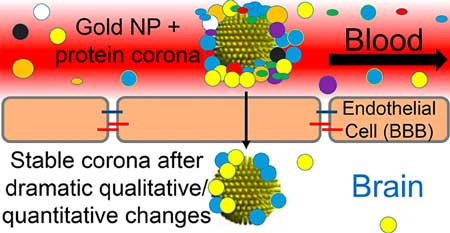| Posted: Jul 05, 2018 | |
Nanoparticle protein corona dramatically affected by blood-brain barrier(Nanowerk News) New research findings (ACS Nano, "Evolution of Nanoparticle Protein Corona across the Blood-Brain Barrier") demonstrate that the protein corona formed on engineered nanoparticles is dramatically affected by interaction with the blood-brain barrier (BBB) and is more stable after it crosses the barrier. |
|
| This emphasizes the role of the protein corona in defining nanoparticle-cell interactions and the importance of using carefully designed biological models when testing nanoparticles for biomedical purposes. | |
 |
|
| Evolution of Nanoparticle Protein Corona across the Blood-Brain Barrier. (© ACS) | |
| Previous reports have shown that when nanoparticles enter the blood stream, the proteins that adsorb onto nanoparticles when they enter the body form a protein corona that hinders interactions between the targeting ligands on the nanoparticles and their binding partners on the cells' surface (read more in our previous Nanowerk Spotlights: "Personalized protein coronas result in different therapeutic or toxic impacts of identical nanoparticles" and "The cellular response to nanomaterials depends on the environment"). | |
| The use of nanoparticles is an interesting approach to overcome the problem of delivering therapeutic and/or diagnostic molecules through the blood-brain barrier to the brain, particularly due to the possibility of multifunctionalization. | |
| However, the biomolecular coating of the protein corona confers a biological identity to nanoparticles, determining how they are recognized by and interact with cells, and likely defines their biological fate, including their biodistribution, cell internalization, intracellular trafficking, and subsequent cellular processing. | |
| In this work, using a cellular model of the BBB and gold nanoparticles, a European team of scientists shows that the composition of the protein corona undergoes dramatic quantitative and qualitative molecular modifications during passage from the blood to the brain side, while it is stable once beyond the BBB. | |
| "Thus, we demonstrate that the nanoparticle corona dynamically and drastically evolves upon crossing the BBB and that its initial composition is not predictive of nanoparticle fate and performance once beyond the barrier at the target organ," the team concludes. |
 By
Michael
Berger
– Michael is author of three books by the Royal Society of Chemistry:
Nano-Society: Pushing the Boundaries of Technology,
Nanotechnology: The Future is Tiny, and
Nanoengineering: The Skills and Tools Making Technology Invisible
Copyright ©
Nanowerk LLC
By
Michael
Berger
– Michael is author of three books by the Royal Society of Chemistry:
Nano-Society: Pushing the Boundaries of Technology,
Nanotechnology: The Future is Tiny, and
Nanoengineering: The Skills and Tools Making Technology Invisible
Copyright ©
Nanowerk LLC
|
|
|
Subscribe to a free copy of one of our daily Nanowerk Newsletter Email Digests with a compilation of all of the day's news. |
